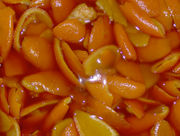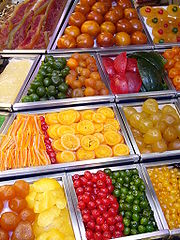
Candied fruit
Encyclopedia


Fruit
In broad terms, a fruit is a structure of a plant that contains its seeds.The term has different meanings dependent on context. In non-technical usage, such as food preparation, fruit normally means the fleshy seed-associated structures of certain plants that are sweet and edible in the raw state,...
, smaller pieces of fruit, or pieces of peel
Peel (fruit)
Peel, also known as rind or skin, is the outer protective layer of a fruit or vegetable which could be peeled off. The rind is usually the botanical exocarp, but the term exocarp does also include the hard cases of nuts, which are not named peels since they are not peeled off by hand or peeler, but...
, are placed in heated sugar
Sugar
Sugar is a class of edible crystalline carbohydrates, mainly sucrose, lactose, and fructose, characterized by a sweet flavor.Sucrose in its refined form primarily comes from sugar cane and sugar beet...
syrup
Syrup
In cooking, a syrup is a thick, viscous liquid consisting primarily of a solution of sugar in water, containing a large amount of dissolved sugars but showing little tendency to deposit crystals...
, which absorbs the moisture from within the fruit and eventually preserves
Food preservation
Food preservation is the process of treating and handling food to stop or slow down spoilage and thus allow for longer storage....
it. Depending on size and type of fruit, this process of preservation can take from several days to several months.
The continual process of drenching the fruit in syrup causes the fruit to become saturated with sugar
Sugar
Sugar is a class of edible crystalline carbohydrates, mainly sucrose, lactose, and fructose, characterized by a sweet flavor.Sucrose in its refined form primarily comes from sugar cane and sugar beet...
, preventing the growth of spoilage microorganisms
Food microbiology
Food microbiology is the study of the microorganisms that inhabit, create, or contaminate food. Of major importance is the study of microorganisms causing food spoilage. "Good" bacteria, however, such as probiotics, are becoming increasingly important in food science...
due to the unfavourable osmotic pressure
Osmotic pressure
Osmotic pressure is the pressure which needs to be applied to a solution to prevent the inward flow of water across a semipermeable membrane....
this creates.
Fruits that are commonly candied include dates, cherries
Maraschino cherry
A maraschino cherry is a preserved, sweetened cherry, typically made from light-colored sweet cherries such as the Royal Ann, Rainier, or Gold varieties...
, pineapple
Pineapple
Pineapple is the common name for a tropical plant and its edible fruit, which is actually a multiple fruit consisting of coalesced berries. It was given the name pineapple due to its resemblance to a pine cone. The pineapple is by far the most economically important plant in the Bromeliaceae...
, and ginger
Ginger
Ginger is the rhizome of the plant Zingiber officinale, consumed as a delicacy, medicine, or spice. It lends its name to its genus and family . Other notable members of this plant family are turmeric, cardamom, and galangal....
. The principal candied peels are orange and citron
Citron
Not to be confused with Cintron.The citron is a fragrant citrus fruit, botanically classified as Citrus medica by both the Swingle and Tanaka systems...
; these with candied lemon peel are the usual ingredients of mixed chopped peel (which may also include glacé cherries). The marron glacé is among the most prized of candied confections.
Recipes vary from region to region, but the general principle is to boil the fruit, steep
Steeping
Steeping or weltering may mean:# Saturation in a liquid solvent to extract a soluble ingredient, where the solvent is the desired product. Tea is prepared for drinking by steeping the leaves in heated water to release the flavor and nutrients...
it in increasingly strong sugar solutions for a number of weeks, and then dry off any remaining water.
History
The food preservation methods using sugar (palm syrup and honey) were already known to the ancient cultures of China and Mesopotamia. It was often the only method of preservation known: The ancient Romans preserved even the fish by soaking it in honey. However, the real precursors of modern candying were the Arabs, who served candied citrus and roses at the important moments of their banquets. With the Arab domination of parts of southern Europe, the candied fruit made its way to the West. The first documents that demonstrate the use of candied fruit in Europe date back to the sixteenth century. At that time, the candied fruits were treated like spices. In Italy, they become a key ingredient of some of the most famous sweets of its culinary tradition: among these, the Milanese PanettonePanettone
thumb|200px|right|A non-traditionally shaped panettone loaf.Panettone is a type of sweet bread loaf originally from Milan , usually prepared and enjoyed for Christmas and New Year in Italy, Malta, Brazil, Germany and Switzerland, and is one of the symbols of the city of Milan. Maltese nationals are...
and the Cassata Siciliana
Cassata
Cassata or Cassata siciliana is a traditional sweet from the area of Palermo, Sicily, Italy. Cassata may also refer to a Neapolitan ice cream containing candied or dried fruit and nuts....
.

